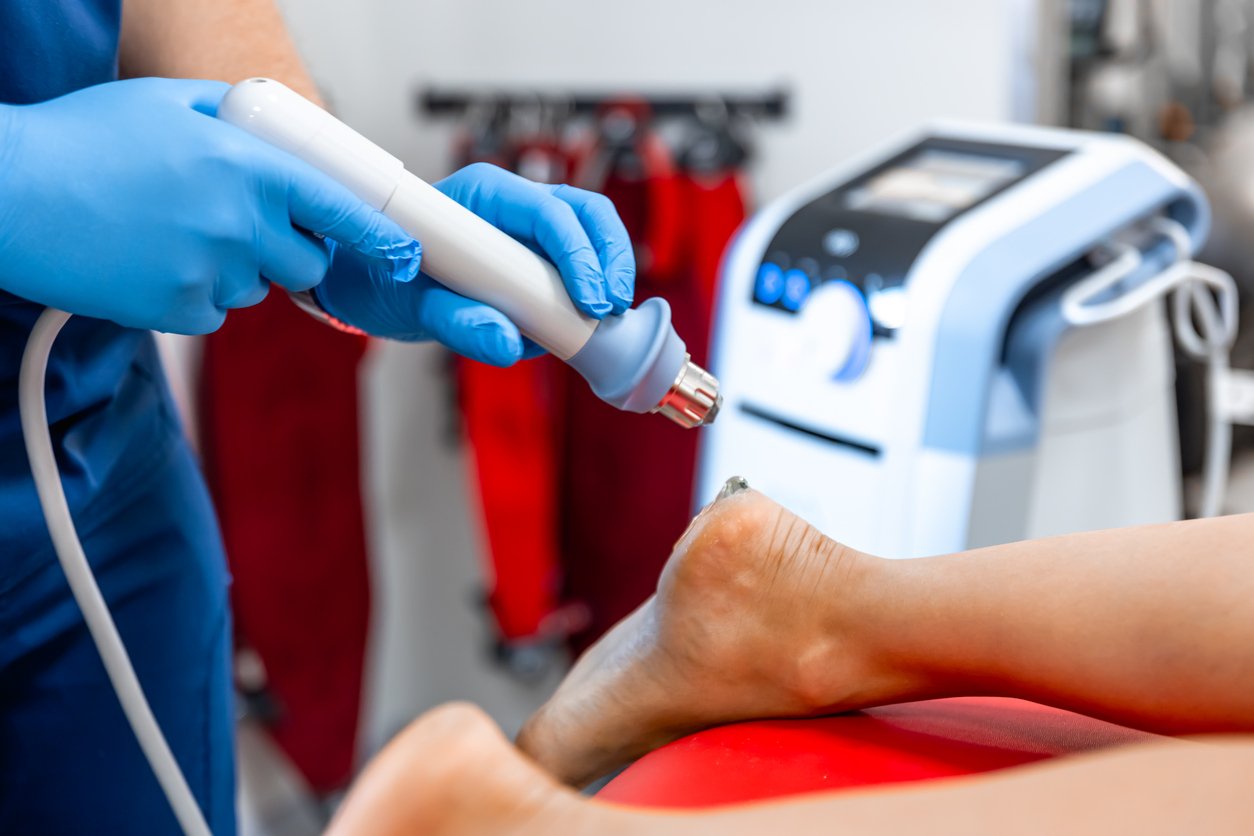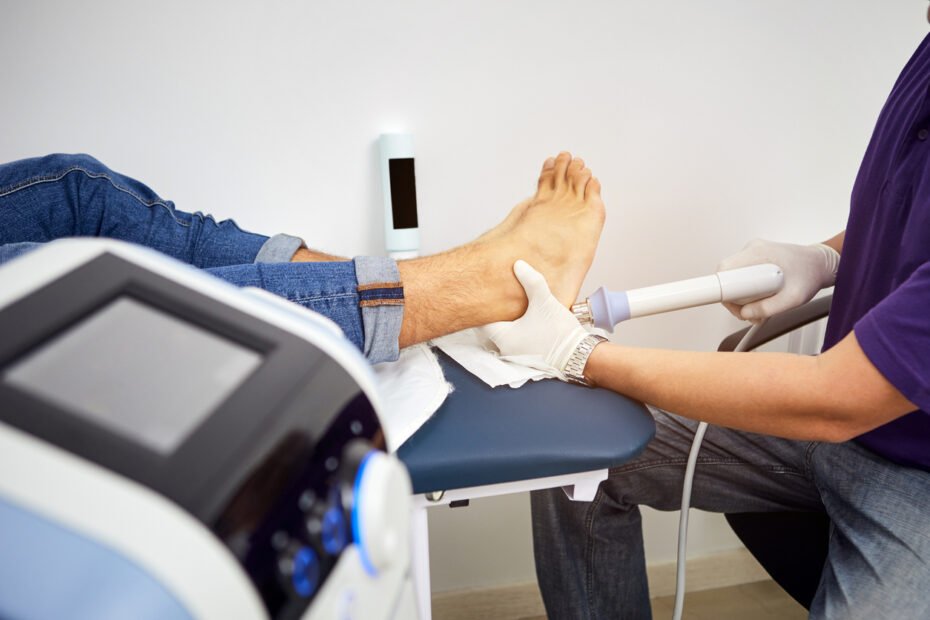In the quiet hours of the morning, as the city sleeps and the first rays of dawn stretch across the sky, a runner laces up her shoes. Each step is a testament to her determination, but also a reminder of the sharp, stabbing pain in her heel—plantar fasciitis. She, like millions of others, is on a quest for relief, a journey that has led many to explore the potential of shock wave therapy for plantar fasciitis.
Understanding Plantar Fasciitis
Plantar fasciitis affects approximately 1 in 10 people at some point in their lives, making it one of the most common causes of heel pain. It involves inflammation of the plantar fascia, a thick band of tissue that runs across the bottom of your foot and connects your heel bone to your toes. Sufferers typically experience a sharp, stabbing pain that is most severe with the first steps after waking up, although it can also be triggered by long periods of standing or when getting up from a seated position.

The Quest for Relief: Shock Wave Therapy
Enter shock wave therapy (SWT), a non-invasive treatment option that has been gaining traction among healthcare professionals and patients alike. SWT uses acoustic waves to deliver a series of high-energy impulses to the affected area, with the goal of reducing pain and promoting healing.
Is Shock Wave Therapy Effective?
The effectiveness of shock wave therapy for plantar fasciitis has been the subject of numerous studies. A systematic review and meta-analysis published in the Journal of Orthopaedic Surgery and Research found that SWT significantly improved pain, function, and quality of life for sufferers of plantar fasciitis. Specifically, patients reported a significant reduction in pain and improvement in function after undergoing the treatment, with effects lasting up to 12 months post-therapy.
Another study, featured in the American Journal of Sports Medicine, highlighted the success rate of shock wave therapy, noting that over 70% of patients experienced substantial pain relief and were able to return to their daily activities without the need for further intervention. These findings suggest that SWT is not only effective in alleviating the symptoms of plantar fasciitis but also in facilitating a quicker return to normal activities.
Defining Shock Wave Therapy
Shock wave therapy, also known as wave therapy or shock wave treatment, is a non-invasive procedure that utilizes high-energy sound waves to stimulate healing in the affected area. The waves are focused and targeted, delivering energy pulses to the tissues, triggering the body’s natural healing response.
These high-energy shock waves promote tissue regeneration, increase blood flow, and reduce inflammation, aiding in the healing process of soft tissue injuries. Shock wave therapy is considered safe, outpatient, and well-tolerated, making it an ideal alternative to invasive treatments for plantar fasciitis.

Benefits and Risks of Shock Wave Therapy
In considering the treatment of plantar fasciitis, it’s important to weigh the benefits and risks of extracorporeal shockwave therapy. Clinical studies have shown that this method can effectively address chronic inflammation in the heel bone and bottom of your foot. However, some individuals may experience foot pain or discomfort during the process.
Understanding these aspects, et al, can help patients make informed decisions about their treatment options. Various risk factors should be considered when opting for this procedure, including the potential for periods of time required for recovery post-treatment.
Pros of Shock Wave Therapy for Plantar Fasciitis
Stimulating the healing process, boosting blood flow to the affected area, and offering non-invasive treatment are key benefits of shockwave therapy for plantar fasciitis. This approach not only relieves pain in chronic cases but also shows significant improvements, making it an ideal alternative to surgery. With studies supporting its efficacy, this treatment stands out among different modalities for managing plantar heel pain.
The use of high-energy sound waves in extracorporeal shockwave therapy has shown promising results in the treatment of chronic inflammation.
Cons of Shock Wave Therapy for Plantar Fasciitis
Patients undergoing treatment may encounter mild discomfort due to high energy sound waves. Sessions typically last 10-15 minutes, but multiple sessions may be necessary for optimal outcomes. Severe plantar fasciitis cases might not respond well to shockwave therapy. Responsiveness varies among individuals, warranting careful consideration. This non-invasive treatment, while effective for many, may not be the ideal alternative in all situations
.

Practical Aspects of Shock Wave Therapy
Understanding the practical aspects of extracorporeal shockwave therapy involves considering treatment periods, energy sound waves’ application, and clinical studies on chronic inflammation. The treatment of plantar fasciitis et al. with high-energy sound waves focuses on the inflamed area near the heel bone.
Numerous studies indicate a significant difference in reducing foot pain and improving the thickness of the plantar fascia. This therapy emerges as an ideal alternative to address plantar heel pain, backed by randomized controlled trials and its effectiveness in treating Achilles tendinopathy.
Is Shock Wave Therapy for Plantar Fasciitis Painful?
Patients undergoing shockwave therapy for plantar fasciitis usually experience minimal discomfort, often describing a gentle tingling or tapping sensation. The focus of this treatment is on reducing heel pain, with most individuals finding it tolerable and effective in improving foot function.
Number of Sessions Required for Shock Wave Therapy
For optimal outcomes, the number of sessions for shockwave therapy varies depending on individual response. Patients typically undergo multiple sessions, with frequency based on the severity of the condition. Repeat sessions may be necessary for long-lasting pain relief, and results are generally noticeable after several sessions.
This treatment approach involves high energy sound waves targeting the inflamed area in the bottom of the foot. Numerous studies have shown significant differences in the thickness of the plantar fascia post-treatment, making it an ideal alternative for chronic inflammation.

Cost of Shock Wave Therapy for Plantar Fasciitis
The expenses associated with extracorporeal shockwave therapy for plantar fasciitis can vary based on factors like the clinic’s location and the number of sessions required. Studies have shown that this treatment modality, although costly, can be an ideal alternative for chronic plantar heel pain.
Clinical research, including randomized controlled trials, has highlighted the effectiveness of high-energy sound waves in reducing foot pain and inflammation. Understanding the cost of this treatment option is crucial for individuals considering it as part of their management plan.
Comparing the Costs with Other Treatment Options
When considering treatment options for plantar fasciitis, it’s essential to compare costs. Unlike surgical interventions, shockwave therapy is often a more cost-effective choice. Non-invasive treatments like physical therapy may have varied cost structures.
The affordability of shockwave therapy can differ based on healthcare facilities. Long-term benefits should be weighed in decisions regarding treatment costs. The duration of care influences the overall costs of treating plantar fasciitis.

Other Treatment Options for Plantar Fasciitis
Non-invasive treatments for plantar fasciitis include physical therapy, custom orthotics, and night splints. Surgical options, et al, encompass procedures like plantar fascia release or gastrocnemius recession for severe cases. These approaches target the root causes of plantar heel pain, such as inflammation in the heel bone area. Incorporating different treatment modalities can effectively address chronic inflammation in the afflicted area. It’s crucial to consider these alternatives when evaluating the best approach to manage foot pain associated with plantar fasciitis.
Non-Invasive Treatments
Non-invasive treatments for plantar fasciitis, such as physical therapy and orthotic devices, focus on reducing inflammation and managing pain. Physical therapy plays a key role in strengthening foot muscles and enhancing flexibility to aid in recovery. These conservative approaches prioritize pain relief and functional improvement without invasive procedures. By incorporating non-invasive treatments into the management plan, overall plantar fasciitis care can be optimized.
Surgical Treatments
For cases where conservative treatments prove ineffective, surgical options like plantar fasciotomy or partial plantar fascia release are considered. Severe chronic plantar fasciitis cases may require surgery. Recovery involves physical therapy post-surgery. Typically, surgical treatments are reserved for situations where other therapies have not shown results.

Making a Decision
When deciding on the best course of action for plantar fasciitis, it is vital to assess the severity of your symptoms and how you responded to previous treatments. Consulting a healthcare provider can guide you to the most suitable treatment plan. Understanding the benefits and risks of various treatment options, including non-invasive and surgical methods, is crucial. Making an informed decision involves evaluating the pros and cons of each approach to ensure the most effective treatment for your condition.
Who Should Consider Shock Wave Therapy?
Shock wave therapy is suitable for chronic plantar fasciitis cases, offering relief from persistent heel pain. Ideal for those preferring non-invasive treatments, it provides effective pain management without surgery. Consultation with a healthcare provider helps determine if this therapy is a good fit.
Is Shock Wave Therapy the Right Choice for You?
Considering shock wave therapy for plantar fasciitis? This non-surgical option stimulates healing processes, enhancing blood flow and tissue repair. Consult a specialist to understand potential benefits. Evaluation by a healthcare provider is crucial to determine its suitability for you.

Conclusion
Shock wave therapy emerges as a promising solution for those battling the persistent pain of plantar fasciitis. Its non-invasive nature, coupled with significant evidence supporting its efficacy, makes it a compelling option for sufferers seeking relief. While the journey to recovery may vary for each individual, the quest for an effective treatment need not be a solitary one. With resources like TheHeelGP.com at your disposal, the path to healing and returning to the activities you love becomes clearer.
As we consider the strides made in treating plantar fasciitis, one can’t help but wonder, what other innovations await on the horizon?
I hope you found this blog helpful and please feel free to comment and share.
Thanks for reading!
 | Tracy J. Founder, The heel GP |
